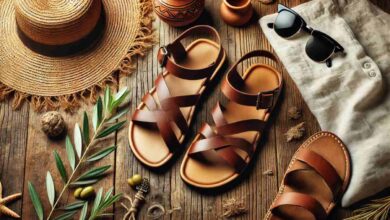Ultimate Belt Size Chart for Perfect Fit and Comfort

Why Belt Size Matters
Before diving into the belt size chart, it’s important to understand why the right belt size matters. A belt that’s too tight will dig into your waist and cause discomfort, while a belt that’s too loose will fail to hold your pants in place.
The right belt size ensures that your trousers fit comfortably, stay in place, and look neat. It also enhances your overall appearance, making your outfit appear more polished and well put together. A well-chosen belt can boost your confidence and bring a whole new dimension to your style.
How to Measure for Belt Size
Knowing your waist measurement is key to selecting the right belt size. The easiest way to measure your waist is with a soft measuring tape. Here’s how you can measure your waist for a belt:
Find your waist size: Measure around the area where your pants usually sit, which is around the belly button level.
Check the fit: Ensure that the measuring tape is snug but not tight. Breathe normally while taking the measurement.
Round up: If your waist measurement falls between two sizes, round up to the nearest inch or centimeter. This will help ensure a comfortable fit.
Ultimate Belt Size Chart
Now that you know how to measure, let’s take a look at the belt size chart. The chart below shows standard belt sizes based on waist measurements.
| Waist Size (inches) | Belt Size (inches) | Belt Size (cm) |
| 28-30 | 30 | 76.2 |
| 30-32 | 32 | 81.3 |
| 32-34 | 34 | 86.4 |
| 34-36 | 36 | 91.4 |
| 36-38 | 38 | 96.5 |
| 38-40 | 40 | 101.6 |
| 40-42 | 42 | 106.7 |
| 42-44 | 44 | 111.8 |
| 44-46 | 46 | 116.8 |
How to Use the Belt Size Chart
Using the belt size chart is simple. First, find your waist measurement in the left column (in inches or centimeters). Then, look to the right for the corresponding belt size. For example, if your waist measures 32 inches, you should choose a belt size of 34 inches. This extra 2-inch allowance ensures that the belt will fit comfortably and leave room for adjustments.
Understanding Belt Sizes for Different Types of Belts
Belt sizes can differ depending on the type of belt you are buying. Here are some common types of belts and how their sizing might differ:
Leather Belts: These belts are typically designed to match your waist measurement, so a leather belt for a waist size of 32 inches will usually be a size 34 belt.
Jeans Belts: Jeans belts tend to be slightly shorter in size, and you may need to go one size up compared to the regular leather belt size. For example, if your waist is 32 inches, you may want to choose a size 36 belt.
Dress Belts: For dress belts, you should choose a size that is one or two inches larger than your actual waist size, depending on the fit you prefer. Dress belts tend to be more form-fitting to give a sleek look.
Casual Belts: Casual belts can be similar in size to leather belts. For these, it’s important to ensure that the belt fits properly at the waistband and allows room for comfort.
How to Choose the Right Belt Size for Comfort
Comfort is key when selecting a belt, so it’s important to consider not only the waist measurement but also the fit. Here are some tips to ensure your belt provides the perfect fit:
Leave room for the hole: A well-fitting belt should have at least 2-3 extra inches beyond your waist measurement. This ensures that the belt can be adjusted for comfort without being too tight.
Adjust the buckle: The buckle should sit in the center of your waist. If your belt has too much extra length, you can use a hole punch to create a new hole that suits your size.
Check the fit with pants: Try on the belt with the pants or jeans you’ll wear it with. The belt should sit comfortably on your waist without causing any bulging or discomfort.
Common Mistakes When Choosing a Belt Size
Even with a size chart, people can still make mistakes when buying a belt. Here are some common errors to avoid:
Choosing the wrong measurement unit: Always check whether the belt size is listed in inches or centimeters, especially when shopping online or from international stores.
Buying a belt too tight: Belts that are too tight can dig into your waist and cause discomfort. Always select a belt with an extra inch or two for a comfortable fit.
Not considering the belt type: Remember that different belts (jeans, dress, casual) may require different sizing, so don’t assume that all belts follow the same measurement rules.
Belt Length vs. Waist Size
Belt length does not always match waist size exactly, as belts are usually designed with extra length for adjustments. For instance, if your waist is 34 inches, a belt size of 36 inches is recommended. The extra 2 inches provide ample room to adjust the belt without it being too tight or loose.
Other Factors to Consider When Buying a Belt
Besides the size, there are a few other things to consider when choosing the perfect belt:
Material: Leather, fabric, and synthetic materials all offer different feels and styles. Leather belts are more formal, while fabric or casual belts offer a relaxed vibe.
Belt Width: Standard belt widths are around 1.25 to 1.5 inches. A wider belt may be more appropriate for casual wear, while a thinner belt works better for formal occasions.
Buckle Style: The buckle style can affect the fit and look of the belt. Choose a buckle that matches your style and the occasion.





